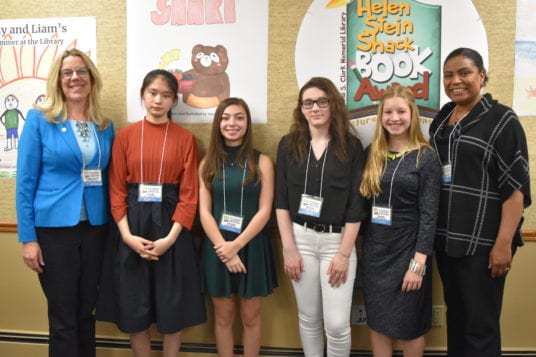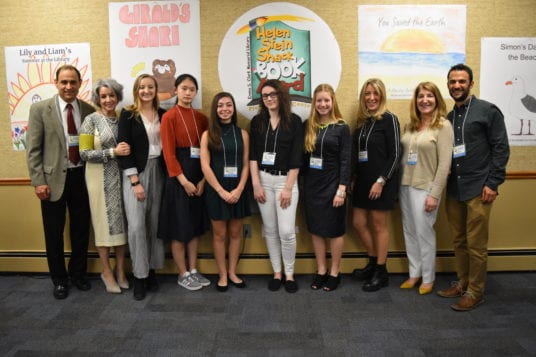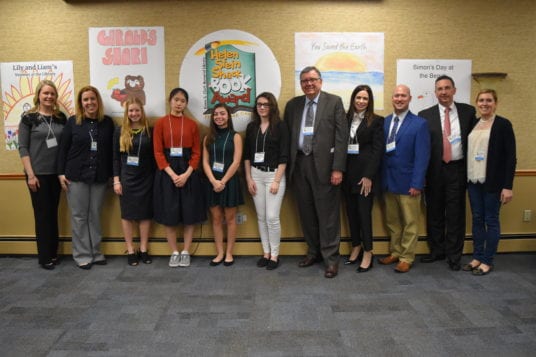Emma S. Clark Memorial Library, 120 Main St., Setauket invites children to drop by on Nov. 16 between 1 and 3 p.m. to make a free craft. Choose between a Thanksgiving turkey picture magnet and a hand-print hanging turkey craft. No registration required. Open to all. Call 631-941-4080 for further information.
Emma S. Clark Memorial Library
End of story: Local libraries, county fear future of e-book lending limitations
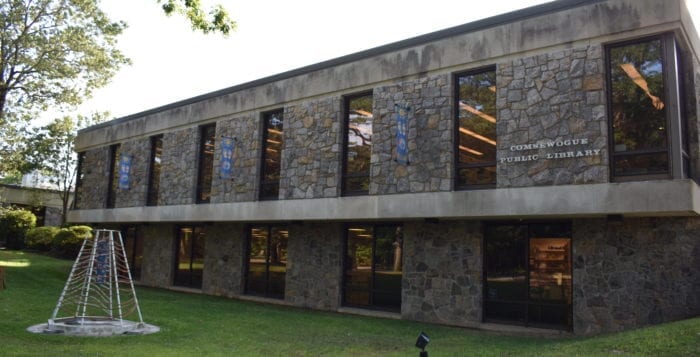
As the internet has connected the world, libraries across Suffolk County have never been as linked as they are today with both patrons and each other.
The written word is strong, despite claims to the contrary, especially with the proliferation of e-books and audiobooks. Suffolk County’s Library System allows for libraries to request books from fellow libraries and gives access to multitudes of e-books and audiobooks alike, all free on request, barring a wait list.
Some publishing companies are not happy with the status quo.
Macmillan Publishers, an international corporation and one of the top five publishing houses across the globe, announced its intent to limit the number of copies allowed to libraries to one for the first eight weeks of release starting Nov. 1. After those eight weeks, they can purchase “expiring” e-book copies which need to be re-purchased after two years or 52 lends.
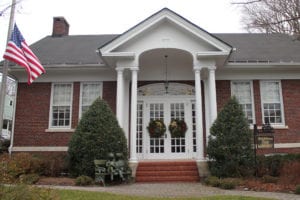
While this decision has rocked libraries across the country, in Suffolk County, as the interlibrary program and e-book lending is handled by the Suffolk Cooperative Library System, that will mean one copy of an e-book for the entire system, according to Kevin Verbesey, director of the county library system. Just one e-book license for the whole of Suffolk and its near 1.5 million residents for the first eight weeks of its release.
To add some perspective, Verbesey said a hot new title could have thousands of residents on a wait list for the title, and the county library system usually tries to have one copy of said book for every two or three people requesting it. Like any anticipated piece of media, new and highly anticipated titles are most often sought and bought in those first eight weeks. Following that, barring renewed interest from something like a movie deal, attention begins to wane. Basically, the library system, which would usually purchase hundreds of licenses of that book, will effectively be restricted from having any.
In socioeconomic terms, Verbesey said it means people who can afford it can buy a book. Those who can’t afford it will have their access restricted.
“In some parts of the county where there’s not great socioeconomic need, people have the option to ‘press buy’ and buy it for $12, but that’s not the case everywhere,” Verbesey said. “Rich people can have it, but poor people can’t.”
The North Shore is one of Suffolk County’s heaviest concentration of library users, the county library system director said. Those patrons could see some of the biggest impact of this decision.
Debbie Engelhardt, the Comsewogue Public Library director, said her patrons are savvy and know when books are set to hit the street, and they depend on the library to have e-book copies available.
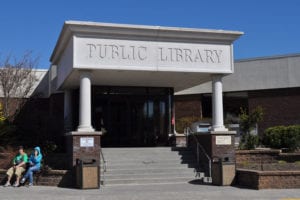
“We have a long history of working very hard to get things into people’s hands as quickly as we can,” she said. “Think about a tiny little library someplace, they can buy one, and then all of Suffolk County can buy one. It just doesn’t seem equitable.”
Engelhardt said libraries often have deals to purchase books cheaper than retail price through deals with publishers. They will also create lease agreements to gather numerous copies of whatever is popular at the time, so they are not later burdened with multiple copies of that same tome.
Ted Gutmann, the director of the Emma S. Clark Memorial Library, also pointed to the interlibrary loan system, which means not every library will need to purchase every book as long as it’s available nearby.
E-books, on the other hand, are purchased by libraries for sometimes five times its original asking price. A regular e-book could cost around $12. A library or library system will purchase it at around $50 or $60, according to Verbesey. This is because libraries need to buy the licensing agreement of the copy in order to lend it to multiple people over the course of its license before the agreement expires in a few years. Each publisher has different policies on how long the licenses last and what is the cost for relicensing a product.
The Suffolk library system has an annual budget of $14 million, with $4 million being spent directly on e-books and for the services of Overdrive, an application used by libraries to distribute their electronic media. E-books currently make up approximately one of every four checkout items from libraries in Suffolk.
Despite the price of these books, Verbesey said they are happy to purchase what can be hundreds of licenses of that one e-book if there’s demand. This new policy would make it pointless to purchase any copies.
Macmillan did not respond to a request for comment, but in its original July 25 letter to Macmillan authors and agents announcing the change, CEO John Sargent wrote, “It seems that given a choice between a purchase of an e-book for $12.99 or a frictionless lend for free, the American e-book reader is starting to lean heavily toward free … Our new terms are designed to protect the value of your books during their first format publication. But they also ensure that the mission of libraries is supported. They honor the libraries’ archival mandate and they reduce the cost and administrative burden associated with e-book lending. We are trying to address the concerns of all parties.”
The changes came after the corporation tested a 16-week embargo with e-books from its subsidiary Tor Publishing, concluding e-book lending had a negative impact on sales.
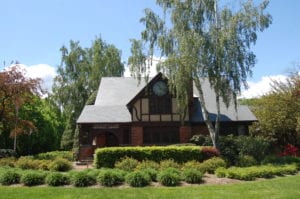
Overdrive CEO Steve Potash condemned the move, calling the company’s original test data faulty adding that very few Tor e-books are available in public library catalogs. He pointed to other studies that showed libraries had no material impact on e-book sales.
Authors published under MacMillan include romance author Nora Roberts, young adult fantasy based in African myth Tomi Adeyemi, and even famous and deceased authors such as C.S. Lewis. The company is also set to publish whistle-blower Edward Snowden’s memoirs this month, which is sure to become a hotly requested item.
And though the libraries have no control over the publisher’s requests, some expect the onus to fall on the individual libraries themselves.
“When a library serving many thousands has only a single copy of a new title in e-book format, it’s the library — not the publisher — that feels the heat,” said American Library Association President Wanda Brown in a July 25 statement. “It’s the local library that’s perceived as being unresponsive to community needs,” she added.
Engelhardt pointed to data from the national Library Journal’s Generational Reading Survey for 2019, which showed 42 percent of those surveyed purchased the same book they borrowed from the library, and 70 percent bought another book of the same author of a book they borrowed. She added libraries are some of the biggest promoters for individual books, authors and literacy in general, and Macmillan may only be hurting its own brand.
While the limitation on e-book lending won’t be in effect until November, libraries are already preparing to tell their patrons why Macmillan books won’t be available electronically.
“We’re going to have to explain the publisher is not working with local libraries,” she said.
Emma Clark library budget vote set for Sept. 18

Emma S. Clark Memorial Library’s budget is projected to increase slightly in 2020, and Three Village school district residents will get a chance to vote on it Sept. 18.
Voters will be asked to approve the library’s 2020 budget of $5,495,366, which is a 1.99 percent increase over the 2019 budget of $5,388,195. While the budget includes an increase of $5,560 in employee salaries, it also consists of a decrease of $37,589 in benefits.
Library Director Ted Gutmann said this past year some full-time Emma Clark employees retired. They were mostly replaced by part-time workers when it was practical, which has impacted salaries and decreased benefits.
Books, e-books, materials, classes and events will see a $51,200 increase in 2020 and building and operations an increase of $6,000. The library’s estimated income for 2020 dips by $82,000.
Orlando Maione, president of the library’s board of trustees, said the board looks for cost-saving methods and applies for grants whenever possible. When the building’s lighting was converted to LED lights, he said it also helped the library save on utility bills. Over the past few years, mechanical equipment has been converted into energy-efficient units which also saves money.
“Whenever we can, we’re constantly looking for ways to save money and not use taxpayers’ money,” Maione said.
The board president said he feels the library and trustees have built trust with residents in that the board will keep costs down.
“Since we all live in the community, and we’re all taxpayers, it’s our money as well,” he said.
Gutmann said he is grateful for the community’s support in the past and feels voting on the budget is important.
“They have the opportunity to voice their opinion,” Gutmann said. “I’m hopeful that they’ll continue to support the library as we’re proposing.”
Registered voters can cast their ballots on the library’s budget between 10 a.m. and 9 p.m. Sept. 18 in the Periodicals Room of Emma S. Clark Memorial Library, located at 120 Main St. in Setauket.
For more detailed budget information, visit www.emmaclark.org.
North Shore researchers and locals plead to school districts for later start times

By Kyle Barr and Rita J. Egan
Come September, middle and high school students across the North Shore will wake up to the harsh sound of alarms, sometimes hours before the sun will rise.
Some will wake up late, and rush in and out of the shower, sometimes not having time to eat before they make it to the bus stop, often in the dark where the cicadas continue to buzz and the crickets chirp.
Port Jefferson high schoolers will shuffle through the front doors before 7:20 a.m. Students at Ward Melville High School will hear the first bell at 7:05, while Comsewogue students will be in their seats at 7:10.
Some scientists across the North Shore have said that needs to change.
The science
Brendan Duffy has worked in St. Charles Hospital’s Sleep Disorders Center for nearly a decade, coming out of working at Stony Brook University as a sleep technician. As he worked in the field, he started seeing significant connections between the effectiveness of individuals during the day and how much sleep they got the night before. For teens, he said, the importance is all the greater. Sleep, he said, has a direct impact on risk-taking versus making smart choices, potential drug use, obesity and depression.
“The science is irrefutable,” he said. “Basically, anything you do, whether it’s mentally or physically — it doesn’t directly cause [these harmful decisions], but there’s connections and links.”
While some parents would simply tell their kids to get off their phone or computer and go to bed, scientists have said the bodies of young people, specifically teenagers, have internal clocks that are essentially set two hours back. Even if a young person tries to fall asleep at 9 p.m., he or she will struggle to slumber. Duffy said scientists call it the delayed sleep phase, and it directly affects the timing of the body’s melatonin production.
During sleep, the body enters what’s called “recovery processes,” which will regulate certain hormones in the brain and effectively flush all waste products from daily brain activity. Without enough sleep, these processes do not have time to work.
“The science is irrefutable.”
— Brendan Duffy
That is not to mention rapid eye movement sleep. REM sleep is a period during the night where heart rate and breathing quickens, and dreams become more intense. Lauren Hale, a sleep researcher and professor of preventive medicine at Stony Brook University, called this period critical to sleep. The longest period of REM happens in the latest part of the sleep cycle, the one deprived by waking up early.
“For decades, scientists have known young people are sleep deprived,” she said. “It’s not that they can get by on six or seven hours of sleep … teenagers are the most at risk of not getting the sleep they need.”
Of course, it is not to say modern technology has not affected young people. Duffy said phones and computers have meant the brain is never given time to rest. Even in downtime, minds are constantly active, whether it’s playing video games or simply scrolling through Facebook.
“They’re not given a break,” Duffy said. “Their brains are constantly processing, processing, processing.”
Sleep and sports
“I looked at all the school athletic programs that have been decimated by changing their start times, and I couldn’t find anything,” Duffy added. “It’s hard for athletes to perform or recover if they’re not sleeping well at the high school level.”
In research, college football teams looked at which kids were likely to be injured, and those who received less than eight hours of sleep were 70 percent more likely to be injured, according to Duffy.
That research led him to find Start School Later, a nonprofit national advocacy group to change the minimum school start time to 8:30 a.m., at a minimum. Duffy communicated with the nonprofit to provide data on the effect lack of sleep has on players. He has become its athletic liaison.
He points to professional sports teams, many of which have sleep professionals whose jobs are to set sleep schedules for their players and help reach peak effectiveness.
History of sleep and schools
Dr. Max Van Gilder is a retired pediatrician and coordinator for the New York branch of Start School Later. He said that while most schools traditionally started at 9 a.m. for most of the 20th century, the move toward earlier start times was relatively recent, only beginning around 1975 with busing consolidation. Schools started doing multiple bus runs for different grade levels, and high school students would be the first ones on these routes.
For decades, the early start became more and more established. Start School Later was created little more than a decade ago, but it’s only recently that some states have started to try later times.
In 2016, Seattle passed a law moving start times from 7:50 to 8:45 a.m. A study of the effects of that change showed students got an average of 34 more minutes of sleep a day or several hours over the course of the week. It also showed an improvement in grades and a reduction in tardiness. The study gave examples that in some classes average grades were up 4.5 points more than previous classes at the earlier start times.
“We need to work with the superintendents.”
— Max Von Gilder
In California, a bill that would have moved minimum start times to 8:30 a.m. was supported by both houses of the state Legislature before being vetoed by the governor last year. A similar bill is currently going through the legislative process again. Other states like Virginia and New Jersey have started to experiment with later start times.
On Long Island, very few districts have made significant increases in start times. Van Gilder said two-thirds of the high schools in New York state (excluding NYC) start before 8 a.m., with an average start time around 7:45. Only 2 percent of high schools start after the recommended time of 8:30, according to him.
The main difficulty of encouraging later start times is due to districts being so largely independent from both the state and each other. While this gives each district particular freedoms, it also means cooperation is that much harder. A district that changes start times would have to renegotiate with bus companies and find ways to navigate scheduling sports games between schools with different start times.
“The state constitution makes it very difficult for the State of New York to pass a law to say when you can start,” Van Gilder said. “We need to work with the superintendents.”
However, proponents of late start said the benefits easily outweigh the negatives.
“There are ways around it and, to me, this is a strong evidence base for opportunity to improve adolescent medical health, physical health, academic outcomes, safer driving — there is such a positive range of outcomes,” said Hale of SBU.
Parents working together
In the Three Village Central School District, more than two dozen parents filled a meeting room in Emma S. Clark Memorial Library Aug. 23. Barbara Rosati, whose daughter is an eighth-grader in P.J. Gelinas Junior High School, organized the meeting to discuss the benefits of teenagers starting school later in the day.
Rosati, a research assistant professor at SBU’s Renaissance School of Medicine in the Department of Physiology and Biophysics, said during conversations with Van Gilder she discovered there are only four high schools in New York that begin school as early or earlier than Ward Melville’s 7:05 start time. Because of their internal clocks, she described the teenagers as constantly being jet lagged.
“Older kids — adolescents, high schoolers, junior high school students — for them it’s much more difficult to get up early in the morning, and this has a physiological
basis,” Rosati said.
The goal of the Aug. 23 meeting was to go over studies, create an action plan and then put that plan into motion. The professor pointed toward the studies that show teenagers who are sleep deprived can be more susceptible to mood swings and drowsiness, and it can affect academic and athletic performance as well as cause long-term health problems such as anxiety, diabetes, eating disorders and cardiovascular problems.
“We’re spending a lot of money in this district to make our schools better and improve their performance, and then we undermine the kids with things like sleep deprivation,” Rosati said. “We undermine not only their health but academic performance.”
“We’re doing this because we care about our children’s mental health and academic achievement.”
— Barbara Rosati
Parents at the meeting agreed they need to be sympathetic to the school board, and Rosati added that she believed, based on prior experience, that the board would be willing to help.
“We have to show them our support, and at the same time we have to make sure they are willing to do this and feel committed to such an effort, because this is not something that you do halfheartedly,” she said.
Frances Hanlon, who has a sixth-grade student in Setauket Elementary School, agreed that the parents can work with the board trustees and that it wasn’t an us-versus-them issue.
“We can’t be, ‘We know better than you and why aren’t you?’” Hanlon said. “We all have to work on this together and that’s what’s going to make a change.”
Rosati and those in attendance are set to survey how many families are in the district and, when the school year begins, will start a petition for those in favor of late start times to sign.
Among the suggestions parents had were bringing the late school start presentation that Rosati created to the school board and PTA meetings throughout the district, with further plans to record and send it by email to parents. One mother also suggested that high school students join the parents at BOE meetings. Rosati said she would also like to have experts such as Van Gilder and Hale present a talk for the board trustees.
“We can use the help of these professionals to inform the board that there is really solid scientific evidence, and we’re not just doing this because we’re lazy and don’t want to get up early in the morning,” Rosati said. “We’re doing this because we care about our children’s mental health and academic achievement.”
Reaction from districts
Both of Duffy’s kids are already graduates of the Port Jefferson School District, and he has yet to present in front of the school board, saying he wants to gain more traction in the community before bringing it to school officials. He has been trying to get support through posts on social media.
“It really can’t come just from me, it has to come from the community,” he said.
Though Hale has gone in front of school boards at Shoreham-Wading River and a committee in Smithtown, she lives in Northport and has two young girls at elementary school level. She has also written editorials in scientific journals about the topic.
When Rosati attended a Three Village board of education meeting in June, she said a few trustees told her that starting high school later in the day could lead to eliminating some of the music programs while teams may not be able to compete against neighboring schools in sporting games.
After her appearance before the school board, she said she researched a number of schools on Long Island, including Jericho High School which starts at 9 a.m. and saw that they could still manage to have music programs and play schools at sports with different start times.
A statement from the Three Village School District said it had commissioned a lengthy discussion regarding school start times, but while it was in support of the research, it identified negative impacts to the athletic programs, transportation, BOCES offerings and elementary music.
The district said it also conducted an informal survey of a small portion of the student population, who said they were not in favor of later starts, but Three Village added it was only used to gather anecdotal information.
“You don’t have to look hard to see the benefits of this.”
— Lauren Hale
There are a few things parents can do to aid their child’s sleep beyond the later start. Rosati offered some tips, including regular bedtimes, providing balanced meals, curfew on screen times, and limiting extracurricular activities and the intake of sugar and caffeine in the evening hours. She and her husband have tried their best to follow those guidelines, but she said they still kept their daughter home multiple days due to sleep deprivation last academic year.
“We should not be put in the position to choose between education and health for our kids,” Rosati said.
When asked, Shoreham-Wading River, Port Jefferson and Northport school districts all said they were not currently looking into later
start times.
Still, Hale said despite her frustrations with the reaction from some districts she’s continuing to argue for later start times.
“We need to work together with communities so that parents and teachers and school board members understand this is for the benefit of the students and the community,” she said. “You don’t have to look hard to see the benefits of this.”
Rosati plans to host another meeting Sept. 10 at the Emma S. Clark Memorial Library in Setauket from 7:30 to 9 p.m.
Helen Stein Shack Picture Book Award winners honored
Emma S. Clark Memorial Library board members and staff, the family of the late Helen Stein Shack, local elected officials, representatives from the Three Village Central School District and guests from the community gathered on April 8 to honor the winners of the fifth annual Helen Stein Shack Picture Book Award ceremony.
The contest called for teens in grades 7 through 12 who live in the Three Village Central School District to create a children’s picture book. Each entry could be the work of a single author/illustrator or a collaborative effort between an author and an illustrator. The contest was divided into two grade categories, grades 7 through 9 and grades 10 through 12, with one first-prize winner and one second-prize winner selected from each group.
Library Director Ted Gutmann, along with the family of Helen Stein Shack, Legislator Kara Hahn and Councilwoman Valerie Cartright presented all of the winners’ books — bound and added to the Library’s Local Focus Collection.
In addition, $400 checks were awarded to first-prize winners Nicole Xiao, an eighth-grader at P.J. Gelinas Junior High School, for her book, “Gerald’s Share” and Juliet Weschke, a 10th-grader at Ward Melville High School for her book, “You Saved the Earth: A Plastic Bottle’s Journey.” Checks for $100 were awarded to the second-prize winners Riley Meckley, a ninth-grader at P.J. Gelinas Junior High School, for her book “Lily and Liam’s Summer at the Library” and Nicole Freeley, an 11th-grader at Ward Melville High School, for her book “Simon’s Day at the Beach.”
The speakers discussed how the contest and ceremony began 5 years ago as a tribute to the late Helen Stein Shack, especially fitting due to her love for learning and her particular fondness for Emma Clark Library. “We would come visit my grandma for a week, and she would take us straight here,” explained Mrs. Shack’s granddaughter Emma Kelly, who flew in from California for the event.
Councilwoman Cartright mentioned to the family that it is “such an amazing way to honor your mom and your grandma’s legacy, her commitment to education, recognizing that literacy is power.”
Leg. Hahn spoke of the special lessons in each book. “When it’s a children’s book, the message does not only get through to the child. The message also gets through to the parent that’s reading it,” she said.
The winners also received certificates from Sen. John J. Flanagan, Assemblyman Steve Englebright, Hahn, Brookhaven Supervisor Edward Romaine, and Cartright. Library board President Orlando Maione, Vice President Deborah Blair, Treasurer Christopher Fletcher, Secretary Carol Leister and trustees David Douglas and Suzanne Shane were also there to congratulate the winners.
Three Village Central School District board of education President William Connors, Superintendent Cheryl Pedisich, Assistant Superintendent for Educational Services Kevin Scanlon, Gelinas Junior High School Principal Corinne Keane, Ward Melville High School English Department Chair Vincent Cereola, Gelinas Junior High School English Department Chair Michelle Hanczor and Gelinas Junior High School Librarian Nicole Connelly were all in attendance.
Guests enjoyed special treats donated by The Bite Size Bake Shop, a local Three Village-owned business and Ward Melville High School teen volunteer Ashley Mullen photographed the event.
The library is grateful to the children of the late Helen Stein Shack, who have established a substantial endowment with the library to cover the cost of the awards as a tribute to their mother and her commitment to passing along the importance and joy of reading for generations to come.
Mrs. Shack’s son, Ed Taylor, spoke about the hard work and dedication that the winners and all of the participants have shown, and then imagined a glimpse into their futures. “These kids are going to grow up, and hopefully, they’ll have families of their own … and one night their kids are going to be lying in bed and ask for a good night story … and they’ll take a book off the shelf, and they’ll read it to their kids … and then they’ll tell them who the author was. That they wrote that book.”
Added Cartright, “I’m delighted today to encourage you to continue using your creativity to share with others, to uplift others, because that’s what you’re doing by creating these books.”
All photos by Ashley Mullen
Setauket library invites residents and nonresidents to prom boutique

Three Village residents are teaming up with the Emma S. Clark Memorial Library to help students have the prom of a lifetime.

On March 9, the library will debut a one-day shopping event called Project Prom Dress where teenagers can walk away with a free gown. Irene Berman, a retired Minnesauke Elementary School teacher, said she was watching a television show featuring a segment about teenagers purchasing prom gowns for a small fee at a library in Parsippany, New Jersey. The dresses were collected by the library’s friends group to help students in need.
“It was so uplifting,” Berman said. “I was actually crying watching it.”
The retired teacher thought it was a good idea to bring to her own area, and she and Kathryn Hunter, who currently teaches fifth grade at Minnesauke, presented the proposal for a prom boutique where students can get dresses for free to a library board trustee.
Library Director Ted Gutmann said the board thought it was a good idea and then formed a team that includes Nanette Feder, teen services librarian; Lisa DeVerna, public relations and community engagement; and Jen Mullen, librarian and public relations.
Berman said the boutique will be opened to residents and nonresidents and is ideal for those on a tight budget or those who want to go green by wearing a recycled dress instead of buying a new one that will most likely only be worn once. Feder added the boutique is also a good opportunity for younger students who are being invited to the senior prom for them to save money on a gown.
The teen services librarian said the library started collecting dresses Jan. 1, and they already have more than 60.
“I’m looking forward to having the students coming in and seeing what the community donated,” Feder said.
“I’m looking forward to having the students coming in and seeing what the community donated.”
— Nanette Feder
Berman said she and Hunter recently visited stores in Stony Brook Village Center to see if any businesses could donate racks to hold the dresses. Ann Taylor Loft, Madison Niche and Chico’s managers offered racks. Once Chico’s manager heard they were trying to help 60 students, she said she will look into the store donating necklaces for each of the promgoers.
In addition to local stores and residents donating dresses, Feder said the night before the prom boutique event, teens will help sort through the dresses and accessories, earning community service credits for their time.
Gutmann said based on the number of dresses received and the response of residents so far, he is optimistic about the prom event and is grateful to Berman and Hunter for reaching out to the library.
“It shows that our community is active in these kinds of things and wants to help out,” Gutmann said.
Residents and nonresidents can drop off prom gowns and accessories at the library through Feb. 14, and donation racks are located in the library lobby. Dresses must be cleaned and in excellent condition with no stains or tears, and the garments must be brought in on a hanger. Purses, shoes, jewelry and other prom accessories will also be accepted.
The library will hold the shopping event Project Prom Dress in the Vincent O’Leary Community Room March 9. Students can schedule an appointment for the Prom Dress Boutique where they can check out the donated prom gowns, try them on and take one home free of charge. Each shopper is limited to one guest to assist them.
Registration begins Feb. 4 for Three Village residents and Feb. 19 for nonresidents, if spots are still available. Snow date is March 23. To reserve a time slot, call 631-941-4080, ext. 127. The Emma S. Clark Memorial Library is located at 120 Main St., Setauket.
Grazie Italia! A Holocaust survival story
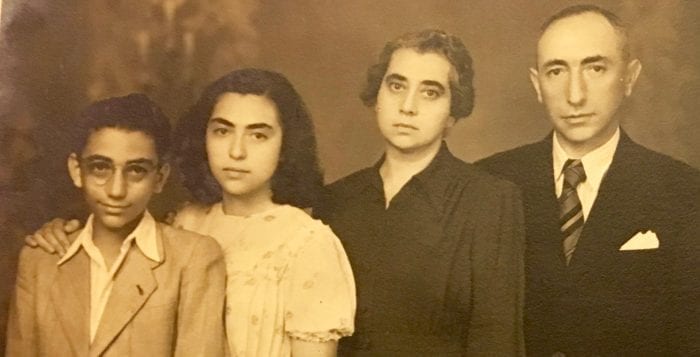
By Donna Newman
Most Holocaust survival stories, told by those still around to bear witness, describe boxcars and concentration camps, starvation and abuse, and the horrific separation of children from their parents.
In a recent program at the Emma S. Clark Memorial Library in Setauket, titled Grazie Italia, local nonagenarian Beruria Stroke told her story of survival and it was quite different. She described a long and tortuous journey from Zagreb, Yugoslavia, to Campobasso, Italy, where advancing Allied forces liberated the Wiener family, who had been fleeing the Nazis — often day by day — for two and a half years.
Stroke’s life story had all the elements of a thriller and, in the discussion that ensued following her presentation, most of those in attendance encouraged her when she said she was thinking about writing a book. The general consensus: It is a story that should be shared.

Speaking without notes, Stroke began her narrative in an idyllic-sounding childhood in Zagreb, Yugoslavia. Her parents, Julius and Frances Wiener, were intellectuals — people of means — and very well read. She credits her father with the ability to foresee the events of the second World War after reading Hitler’s book, “Mein Kampf.”
In 1939 her parents traveled to Palestine, then under British control, and applied for papers for their family to immigrate. As they waited for the papers, they established a plan to leave Yugoslavia. It was a long wait. When transit visas finally came through on April 4, 1941 Beruria, her parents and her younger brother Željko, fled to the east via the famous Orient Express. They only made it as far as Belgrade.
In Belgrade, the train was stopped and all passengers had to find overnight lodgings. They expected to board the train the following morning to continue their journey. But that night, while staying at the apartment of an uncle, young Beruria experienced the horrors of war firsthand. She described hearing sirens at 3 a.m. but then was told it was “just an exercise.” At 6 a.m. there were no sirens — just bombs falling. The next day, after realizing they could no longer go forward, they learned of a train that could take them back to Zagreb. They negotiated the rubble that Belgrade had become, walking past dead bodies in the street. As fate would have it, they missed the train, but were directed to a spot where another train would be forming. They waited there, inside a boxcar. By the time the train left, the boxcar was filled beyond capacity. In Stroke’s mother’s words, “Not a needle could come between one person and another.”
Back in Zagreb, things had changed over night. Jews were made to wear identifying cloth badges bearing the letter Z topped by an accent mark that looked like a V — the letter representing the word for “Jew” in the Croatian language. Heads of families were being arrested and incarcerated. In exchange for their large apartment, Julius Wiener negotiated travel papers and safe transit to a train headed toward the Italian border. Stroke said, “We left in the nick of time. That night the Nazis came [and would have taken us] to a concentration camp.”
Throughout her story Stroke made note of unexpected but lucky moments that allowed her family to survive intact. It was serendipity, she said, that got them through the German occupation — serendipity, and the help of many good people along the way.
After the family made it to Italy, they still had the difficult task of avoiding capture. Stroke told of their journey south along the eastern coast of Italy on bicycles — another of her father’s brilliant ideas — sheltering overnight wherever they could find space, so as not to be outdoors after curfew.
The Wieners were among those liberated by Canadian forces on Oct. 14, 1943 in the city of Campobasso in southern Italy. That event launched the next phase of her young life, which led to her emigration to Palestine in 1945. But that’s another story.
This was only the second time Stroke has shared her story publicly. The first time was this past April at the invitation of Rabbi Joseph Topek of Hillel, a Jewish student organization on the Stony Brook University campus. Israeli premed student Eilona Feder worked with Stroke to facilitate her talk.
Feder is the Israeli-American Council “Mishelanu” (Hebrew for “from ourselves”) intern on campus, tasked with connecting Israeli students as well as offering educational and cultural programs open to all. Feder has been involved in Holocaust education for years, ever since her middle school days in Israel. “I became so involved,” she said, “because my grandfather is a Holocaust survivor, and he was never willing to tell me his story.”
Setauket library receives state grant for LED lights, fixtures

In the days of Kindle, one senator recognizes libraries still play a major part in communities.
Recently, state Sen. John Flanagan (R) announced that four libraries in his district, including Setauket’s Emma S. Clark Memorial Library, would be receiving state funding to offset the cost of construction projects.
“Public libraries are more than books — they are community centers that provide valuable programs and services,” Flanagan said in a statement. “They are a proven resource for residents of all ages and we need to continue to work with the leaders of these facilities to provide them with the funding they need to fulfill their mission.”
The construction grants, which were allocated in the 2017–18 state budget for public library construction and broadband infrastructure projects, total $209,638, and are administered by the New York State Education Department and the New York State Library, according to a statement from Flanagan’s office.
Emma Clark Library received $9,638 for the installation of energy-efficient LED fixtures and bulbs. Ted Gutmann, library director, said the LED project is already complete, and the grant is a reimbursement for the project cost.
“This is win-win for our patrons who won’t have to directly fund the project, and at the same time will get a more efficient library that will help save them money for years to come,” Gutmann said. “Senator Flanagan’s efforts in supporting libraries are much appreciated, and on behalf of the board of trustees and myself, thanks again for being a friend of the Emma S. Clark Memorial Library.”
The Legislature approved an additional $34 million in funding for projects as part of the 2018–19 state budget. The approved projects for that funding will be announced in the summer of 2019, according to the statement.
Library welcomes late artist’s landscapes
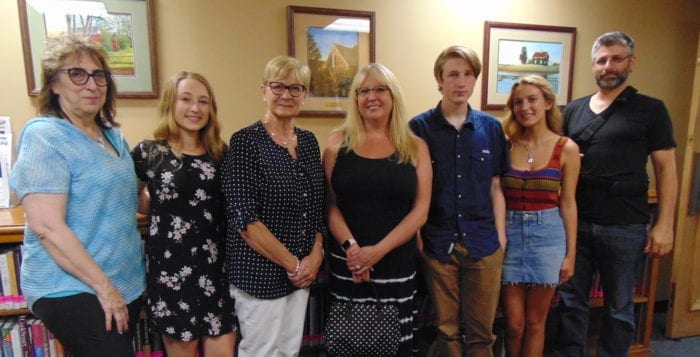
A local artist’s work will live on in the community, even after his death.
Michael Kutzing, who lived in Port Jefferson for 45 years and died in 2015, enjoyed painting nearby landscapes and still lifes, especially scenes in the Setauket area. On July 16, Denise Kutzing and her family donated three prints of her late husband’s paintings to the Emma S. Clark Memorial Library.
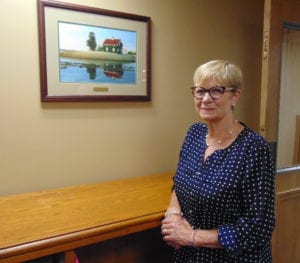
The three pieces the family donated to the library are titled “The Melville Barn,” “Setauket Grist Mill” and “The West Meadow Gamecock House.” The barn and grist mill can be found at Frank Melville Memorial Park in Setauket while the Gamecock house is among the remaining cottages at West Meadow Beach.
Kutzing said her husband, who was a project manager for a land development company, collected maritime art for many years and took up painting, primarily with oil, after his retirement in 2006. He was a self-taught artist who, for more than a year, owned MRK Gallery in Port Jefferson. He was a member of a number of art organizations including The Art League of Long Island and Smithtown Township Arts Council.
When Kutzing saw her husband’s prints at the library, she said she was pleased with how they looked. The Setauket Frame Shop completed the paintings with earth-tone colored matting and wood frames.
“They bring about the essence of the community, and my husband would have been so honored,” Kutzing said.
She said family friend Everett Waters came up with the idea to donate a few prints to the library. Ted Gutmann, library director, said when Kutzing and Waters came to him with the idea he wasn’t familiar with the artist’s work, but after looking at his portfolio he was impressed, especially since many were local, recognizable scenes. He brought the idea to the library board of trustees, and everyone worked together to choose which prints to display.
“They bring about the essence of the community, and my husband would have been so honored.”
— Denise Kutzing
“It’s a good location for it,” Gutmann said. “They look like they belong there, and I think they’re going to attract a lot of attention.”
Waters, a Strong’s Neck resident and former psychology professor at Stony Brook University, said he met the painter when he owned the gallery in Port Jefferson. Waters said he would be amazed that while talking to him, the artist would continue painting, even when creating a detailed piece.
“The level of detail, the colors, the perfection was amazing,” he said.
Waters said Kutzing loved the area, and while he painted other subjects, a lot of the locations were right near the library.
“I thought there should be some way to note the fact that someone had enjoyed the place and seen it in such a way,” Waters said. “Because if you see that someone sees through certain eyes, then maybe you see it more. ‘I should pause. I should go see that barn. When I go to the beach I should see the Gamecock Cottage.’”
The artwork is now displayed outside the Vincent R. O’Leary Community Room on the library’s lower level. Emma S. Clark Memorial Library is located at 120 Main St., Setauket.
Exploring family tree plays a part in local history

By Beverly C. Tyler
In an oral history interview with Joseph Eikov, who was born in Setauket in 1903, he talked about life in East Setauket in the early 20th century. His father came here from Warsaw, Poland.
“They all migrated here,” he said. “My mother [Dora Pinnes] from [Kopyl] Russia … All the Jews migrated here … They were called greenhorns. They came here with badges on. They came here to work in the [East Setauket] rubber factory and after the factory burned down [1905], then they started to leave. That’s when Pinnes [Dora Pinnes’ brother Herman, who opened a kosher butcher shop in East Setauket] went from kosher. They moved away gradually until there were very few left.”
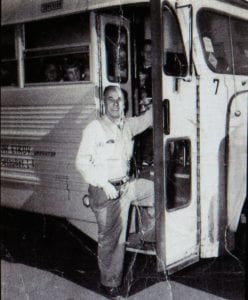
Local history is a combination of the history of people, places and events. All of these elements are needed to understand and enjoy the history of a community or family history. Research into one of these areas naturally spills over into the others. Sources of information are so varied that they cannot be listed or explained in one short article; however, getting started in the exploration of local history is as simple as finding out about your own family’s history.
Without the research provided by family historians, the collections of local history in libraries and historical societies would be much less useful. If your family comes from Long Island, plan a visit to the Suffolk County Historical Society library in Riverhead at 300 W. Main St. The society maintains one of the largest files of genealogical material in Suffolk County. Its Weathervane Gift Shop also has a large collection of books, pamphlets and other materials on Long Island history and genealogy. The Long Island collection in the Emma S. Clark Memorial Library, 120 Main St. in East Setauket, includes a large number of published genealogies. These include both individual and family histories. The manuscript collection of the Three Village Historical Society (the Capt. Edward R. Rhodes Memorial Collection of Local History) in the Emma Clark Library includes a number of typed and handwritten genealogies. Most of these are family histories, but some include extensive information on specific individuals as well.
It is important for more local residents to provide information on their families to be placed in the Three Village local history collection. In this way the history of Setauket and Stony Brook can be kept up-to-date.
The information compiled by family members includes not only the names, dates and relationships of prior generations, but often supplies the interesting stories about their lives that makes local history so interesting. But where to start? Most genealogists recommend that those entering the field for the first time read a good basic book on the subject of genealogy and family history. Researching family history can be an enjoyable undertaking if you dig into the past with the right tools at your disposal.
Family history has, with the advent of the internet, become a popular pastime. There are a number of sites that can help with family research. Start with www.live-brary.com. Click on Local History and Genealogy and then on Topic Guide Genealogy. The Mormons have a free site you can use at www.genealogy.com. Ancestry is a for-profit site at www.ancestry.com that can be accessed for free at the Emma Clark and other local libraries. Heritage Quest, on the other hand, can be accessed from the library or at home by signing in to the library website at www.emmaclark.org. One of many interesting sites for genealogy and family history is www.stevemorse.org.
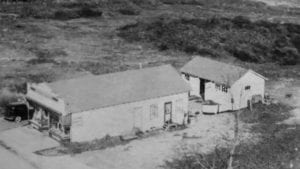
Books on genealogy and family history are available at libraries. At the Emma Clark library, upstairs under 929.1, are books such as: “The Troubleshooter’s Guide to Do-It-Yourself Genealogy” by W. Daniel Quillen (both 2016 and 2014 editions), “How to Do Everything Genealogy” by George Morgan (2015) and “Genealogy Online for Dummies” by Matthew and April Helm (2014). There are also a number of DVDs on genealogy and family history.
To begin your family history, just remember to start with yourself. You are the beginning of the search. Record all the known facts about yourself — birth, baptism and marriage dates — and all of your known brothers, sisters, uncles, aunts, parents and grandparents. Next, use home sources. Find out what kind of genealogical materials you have in your home and relatives’ homes including family bibles, newspaper clippings, military certificates, birth and death certificates, marriage licenses, diaries, letters, scrapbooks, backs of pictures and family histories. Don’t forget to talk to or write to — email if possible — your relatives, even the ones you haven’t spoken to in years. Family gatherings can also provide a good source of information about family history and folklore.
However you get started, get going. You will find the journey well worth the effort.
Beverly C. Tyler is Three Village Historical Society historian and author of books available from the society at 93 North Country Road, Setauket. For more information, call 631-751-3730 or visit www.tvhs.org.







